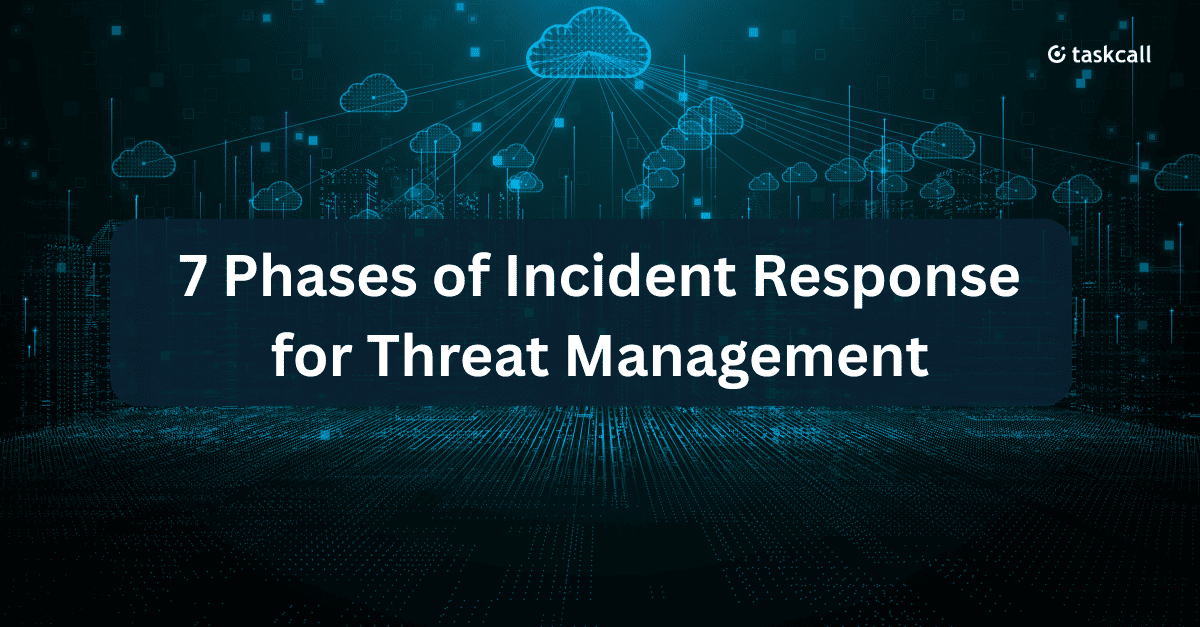7 Phases of Incident Response for Threat Management

The question is no longer when cyber threats will happen, but how you will tackle that situation. As cyber attacks become common and advanced, your organizations need a strategic roadmap to manage security breaches effectively. The roadmap should encompass the 7 phases of incident response, which is a systematic method of dealing with cybersecurity threats from start to end.
This holistic model helps organizations to minimize losses, continue with business activities, and enhance their security systems against future attacks. These 7 steps are important in managing threats, whether it is ransomware, data breach, or phishing attempts. So, let's dive in.
7 Phases of Handling Incident Response
Phase 1: Preparation - Developing Your Foundation
The most important element in incident response is preparation. It is the first step before any incident occurs. Here, you have to focus on building the foundation for a quick and coordinated action.
Policy Development:
Firstly, create a blueprint mentioning who does what during an incident. Here, you will describe roles, responsibilities and communication processes. For example, when an incident occurs, specify who will notify the customers, regulators and law enforcement agencies within the prescribed period. This data breach notification policy must be included in your roadmap.
Team Formation:
Now, make a cross-functional team consisting of IT security experts, system administrators, a legal adviser and communication personnel. Each member should have backup personnel assigned, and they must know their role individually.
Risk Assessment:
Security audits and vulnerability assessments of your organization should be done regularly. By doing so, you can identify potential areas of threat and act accordingly.
Communication Planning:
Develop safe communication methods within the team and among stakeholders. This may include encrypted messaging systems, backup phone numbers, and pre-written communication templates.
Training Programs:
Conduct security awareness training for all employees quarterly. During the training, highlight the most frequent threats, such as phishing mail and social engineering attacks. Your best defense is usually well-trained employees.
Phase 2: Identification - Threat Detection

The identification process aims at fast detection and confirmation of security incidents. The quicker you can detect a real threat, the faster you can start your response activities.
Constant Surveillance:
For continuous monitoring, use Security Information and Event Management (SIEM) systems and Intrusion Detection Systems (IDS) to scan your network for suspicious activities. These monitoring tools can identify unusual patterns of security breaches.
Incident Verification:
When an alert has been raised, it is often necessary to check whether this is a real security incident or not. This process includes checking logs on the systems, network traffic, and behaviors of the users to authenticate the threat.
Classification and Prioritization:
You don't need to give the same response to each and every incident. For the same, consider classifying the incident by its type (malware, phishing, data breach) and its level (low, medium, high, critical). With this, you can understand whether or not you need to deploy more resources.
Notification Process:
Plan a well-defined security incident response process that notifies your incident response team and other important stakeholders. Rapid notification will mean that the response starts as soon as possible.
Technology Support: Advanced Incident response software can automate many of the above processes. It can be detected by correlating information across many sources and can provide real-time alerts. Dashboard interfaces are useful to enable teams to visualize and evaluate incidents in a short time.
Phase 3: Containment - Reducing the Damage
Containment is an attempt to halt the incident and save evidence to examine it in the future. The step is usually characterized by short-term and long-term containment measures.
Short-term Containment:
Here, you have to take immediate action to limit the effect of the incident. This process involves shutting off the system from the network, blocking malicious IPs or deactivating hacked user accounts.
Long-term Containment:
Implement more sustainable solutions that will allow you to continue with daily operations, as you investigate the incident. This includes installing security patches, firewall rule updates, or installing further monitoring on the affected systems.
Evidence Preservation:
You need to preserve the digital evidence in its pre-existing state, which will be useful during forensic investigation and possible court trials. This means you must avoid actions that might modify or corrupt valuable information.
Documentation:
You should also record every action taken during the containment, including the time and the people involved in it. This documentation will be useful later in the analysis and for legal purposes.
Modern incident response software systems have automated containment action capabilities such as predefined rules, isolating infected systems and blocking malicious traffic patterns.
Phase 4: Eradication - Removing the Danger
The eradication step is to eradicate the threat in your environment and to solve the security problem that allowed the incident to occur.
Root Cause Analysis:
Trace the incident occurrence on the logs of the system, on the network traffic, and on user operations. The information regarding attack vectors helps to prevent such incidents in the future.
Threat Removal:
Cull out every artifact of the threat, i.e., malware, backdoors, and other malicious artifacts. It involves antivirus scanning, manual elimination of files, or rebuilding of corrupted systems.
System Hardening:
Install security patches, make updates in settings, as well as add more security measures to avoid repeating similar attacks. This increases your level of security.
Verification:
Inspect all the threats and make sure you have successfully eradicated them, and only then proceed to recovery. This process includes several scans and tests to make it complete.
The latest incident response platforms are connected with antivirus programs, vulnerability scanners, and patch management tools to facilitate the eradication process and offer verification logs.
Phase 5: Recovery - Restoring Normal Operations

Recovery is a process of safely bringing the affected systems back to their normal working state and also making sure that there are no threats lurking in your environment.
System Restoration:
Restore the damaged system with cleaned hardware or software. This way, your baseline will be clean and secure.
Testing and Validation:
Now, check the restored setting to ensure that it works perfectly. This involves testing of functionality as well as security testing.
Improved Monitoring:
After a system is recovered, employ improved monitoring to identify any sign of re-infection or any abnormal activity. This improved awareness helps detect the unnoticed risks.
Stakeholder Communication:
After the recovery process, update the stakeholders about the recovery status and further plans. Open communication can keep things under control and maintain trust.
Phase 6: Lessons Learned - Making a Better Response in the Future
Lessons learned is the stage when you take the whole incident response process and analyze it to recognize areas of improvement and improve your security posture.
Incident Documentation:
Write a comprehensive report about the incident, how it was discovered, planned responses, and what outcome was achieved. This record can be kept as a guide for future incidents.
Response Evaluation:
Check what you did well in your response and the parts that need improvement. Look at communication efficiency, response time and resource usage.
Plan Revision:
Revise your plan of incident response with what you have learned from the incident. It can involve changes in processes, the introduction of new equipment, or changes in organizational teams.
Team Debriefing:
It entails post-incident debriefings with your response team and knowledge sharing to enhance the preparedness of the team. These meetings are useful in capturing organizational knowledge and boosting teamwork.
Incident response software also offers documentation platforms by allowing communication of incidents in detail and progress tracking. Analytic tools have the capability of revealing trends and patterns that can be used in making strategic security decisions.
Phase 7: Continuous Enhancement - Being on Top of the Threats
Constant betterment means that your incident response becomes more advanced with the shifting threat environment and organizational requirements.
Continuous Testing:
You have to conduct regular tabletop testing, penetration testing, and mock drills to ensure that the response plan you have is effective. Such activities help establish gaps and improve team coordination.
Plan Updates:
Keep on updating your response plan with new threats, technologies, and what you learned. The world of cybersecurity is dynamic, and your strategy should be dynamic.
Training Enhancements:
With new attack methods and emerging risks, you need to revise the training programs. Professionally trained teams are more effective when such incidents occur.
Deployment of Tools:
As the tech sector keeps evolving, the newer tools and methods can provide better capabilities. This means you need to evaluate and make improvements in the incident management tools regularly so that they remain useful.
Analytics reporting, and simulation opportunities help to undertake regular enhancements in incident response software. The application performance monitoring tools are practical in monitoring the performance metrics and in providing recommendations regarding industry best practices.
Technology's Role in Incident Response Steps
All 7 steps are incorporated in handling modern incident response and management software. With new tech stacks such as ML and AI integrated into these platforms, it can offer automation to make faster response times, collaborative features, and analytics to streamline the decision-making process.
The main advantages include automating the process of threat detection and response, ensuring secure project management with centralized incident management, provides real-time collaboration tools, extensive reporting options, and supports the integration with currently used security tools.
Final Thoughts on Incident Response
Incident response plays a vital role in cybersecurity by offering an effective way of dealing with security incidents that help organizations to limit losses caused by security breaches, shorten the recovery period, and enhance their security position.
Better security is only achieved through proper preparation, rapid identification, successful containment, total eradication, cautious recovery, constant learning, and continuous growth. This framework is even more effective when supplemented with modern incident response software, giving the automation and coordination ability required in the current threat environment.
Companies that take the time to develop and sustain strong incident response functions are better positioned to survive and prosper in an increasingly dangerous digital environment. Now, the question is, are you ready for such a security incident in your organization?
FAQs about Stages of Incident Response
1. What are the 7 stages of incident response in cybersecurity?
The 7 stages are Preparation, Identification, Containment, Eradication, Recovery, Lessons Learned, and Continuous Improvement. These stages help organizations manage cyber incidents systematically.
2. Why is preparation key in the incident response lifecycle?
Preparation builds a defense in depth by defining policies, building the response team, training and having the tools ready before an incident hits.
3. What role does incident response software play in threat management?
It automates threat detection, speeds up containment, enhances collaboration, supports documentation and integrates with security tools to streamline incident resolution.
4. How can you learn from past security incidents?
By documenting the event, analyzing the root cause, evaluating response efficiency and updating the plans, you'll strengthen future threat response and reduce recurring risk.
5. What is continuous improvement in incident response?
Continuous improvement means updating the plans, refining the training, adopting new tools and running simulations to evolve your cybersecurity with the changing threat landscape.
6. How can TaskCall help with your incident response?
TaskCall gives teams real-time alerting, collaboration tools, response automation and analytics to manage all incident response stages.
You may also like...
Master the security incident response process with expert tips and guidance. Enhance your organization's cybersecurity and effectively manage threats.
Incident response is the process of addressing technical issues that occur in a company. It could be business application errors, database issues, untested deployment releases, maintenance issues or cyber-security attacks. Automation allows such incidents to be resolved fast and save losses.
